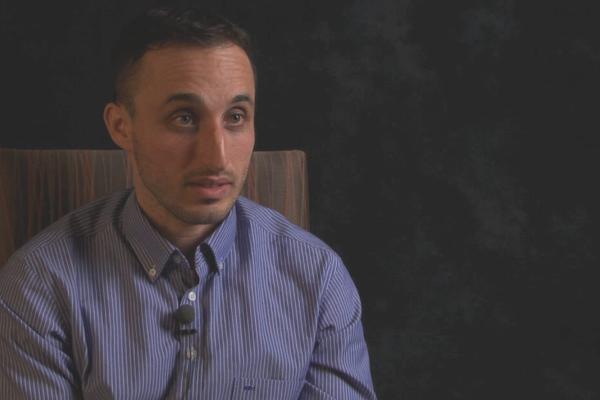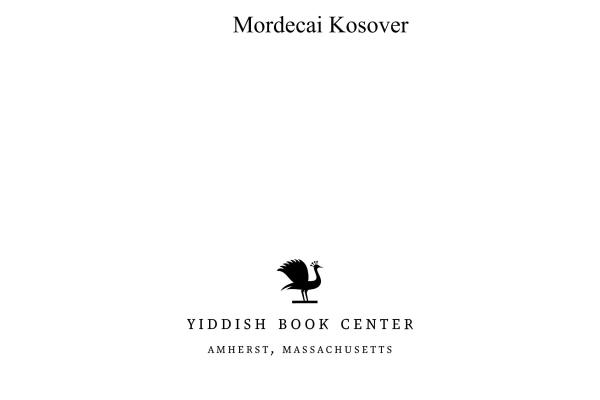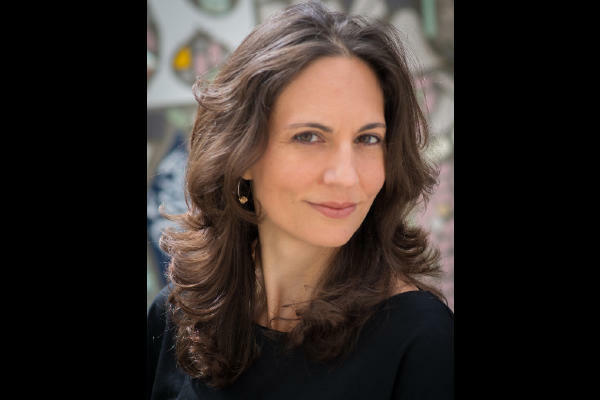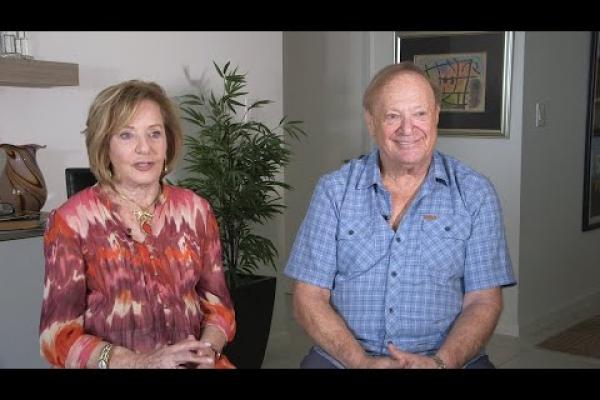About the Holy City and the Sinful Man
An excerpt from the novel "'Boom' and Chains"
— Khonen Klenbort (Kh. Yalti), translated by Adi Mahalel, published on June 15, 2023.
Khonen Klenbort (1910–1992) authored “Bum” un keytn (“Boom” and Chains, 1936), his first Yiddish novel, under his pen name Kh. A-Yalti. The novel was first serialized in the press with the name Troymen un keytn (Dreams and Chains). The change of title sharpened the contrast he wished to illustrate in his epigraph to the novel: “the Land of Israel is ‘booming,’ Palestine is ‘in chains.’” The novel is more polyphonic than hero based, but it loosely follows the character of Zalmen on the last legs of his trip from Europe to Palestine: from the first moments he recognizes Palestine’s shores from the sea to his ultimate break with the Labor Zionist ideology that linked him to the land. The novel is divided into three major parts: “Kibbutz,” “Land and Work,” and “God and Mammon.”
This short excerpt from the novel is the opening of part two, “Land and Work.” It does not reference Zalmen, nor does it take place in a kibbutz. It rather centers on Jerusalem—its multicultural inhabitants and its religious significance alongside its geopolitical significance—and on the character of Milner, the communist Jew interested in a joint struggle with the local Palestinian Arabs against oppression rather than perpetuating inter-ethnic and religious animosity. This excerpt is taken from my complete translation of the novel, supported by the Yiddish Book Center’s Translation Fellowship, which includes my scholarly introduction, glossary, and appendix. — Adi Mahalel
1
Jerusalem is the holiest city in the entire world. There are holy places on every corner, and on every sacred spot is a church, synagogue, or mosque. Wandering throughout the holy city are Russian Orthodox priests, Catholic cardinals, Jewish rabbis, Muslim muftis, and black Abyssinian priests. The stone cloisters of the monasteries are closed off, and by day a cemetery-like stillness dominates the area. The crosses, crescent moons, and sloping walls of the crumbling Jewish study houses all cry out to the heavens.
The Yemenite and Bukhari Jews who arrived later built narrow streets and produced many children. High above, laundry dries on ropes hanging between dark, dusty walls; below, kids play raucously in the filthy alleyways. In the summer, the water in the foul-smelling wells dries up, and old women and small children stand in long lines for a can of water from the city pump. Tourists—who have come to see Christ’s grave or the collectives in the kibbutzim—photograph the lines by the pumps and sip mineral water, which they bring with them in small bottles from abroad.
The grand new buildings around the market are adorned with signs reading “Iraq Petroleum Company,” “Shell Company,” and “Barclays Bank.” English military camps surround the city. In the high commissar’s palace lies the Bible—the New Testament—and a map of the Imperial Air Communication points: London–Cairo–Palestine–Iraq–Persia–India–Hong Kong. The high commissar is responsible for the cradle of the three religions, and for the oil pipes, which go from Mosul all the way to Haifa. The high commissar of Palestine is indeed a man of the Bible, but he also wants to have a strategic path to the pearl of the English crown, that is, to India. On the strategic map of the Empire, Palestine is therefore marked with a thick, black dot.
2
Since childhood the fellah Salim, from the village Shlil, had heard about the floating rock and Buraq, the holy horse of Muhammad. Salim came to Jerusalem by foot. By the gate of Al-Aqsa, he removed his torn shoes, washed his feet, and entered after paying the muezzin a couple of piasters. The muezzin showed him the stone of the patriarch Abraham and of Samuel the prophet, explaining to him: “In the past, the stone hung entirely in the air! Only in recent generations were the small walls by its sides added to it.”
The Jewish Temple, as was well known, had burned to the ground, and only one wall remained intact. But Sarah, the shopkeeper from the Old City of Jerusalem, never gave much thought to the veracity of these words. Only when she realized that income was scarce did she go to the Wall, where she wrote a note to the Master of the Universe, asking him to take away a couple of customers from her neighbor Rokhl and give them to her. Rokhl was also a shopkeeper in the Old City. She also went to shed a tear by the Western Wall and beseeched the Master of the Universe to take away a few customers from her neighbor Sarah and give them to her.
People placed their little notes between the stones of the Wall. The shammes came, took a bit of money from the women, and threw their notes into a pot to burn. Besides the shammes, a tall English soldier with a telephone also stood by the holy Wall. The soldier was not thinking about the holy rock or Muhammad’s flights—he knew you could fly from Jerusalem to Mecca or Bombay by airplane. When something happened, he made a telephone call and soldiers came. And things happened. One case involved a Jew who dreamt of a Jewish state with police, soldiers, airplanes, and uniforms; not being able to wait any longer, he took a shofar and blew it by the Wall, and so he was arrested.
A second case concerned Rabbi Buk, an old Jew with a respectable white beard. The leaders of the Histadrut were on their way to consult with this particular rabbi on how best to lead this sinful generation away from its wicked path and persuade it to cease hiring Arab workers. On the way, in the taxi, the editor of the socialist newspaper said: “The religious emotion is the mightiest of human emotions; it sits in the depths of its soul . . .”
Ben-Hillel, the secretary of the Histadrut, looked out on the small Arab villages settled throughout the surrounding mountains and answered: “Oh, yes, deep in a person’s soul lies religion, in particular in this country, where every rock reminds you of fiery speeches by the Hebrew prophets about justice, equality, and truth, where the dream of world peace was weaved, when lamb and lion will graze together . . . Yes, it will surely help . . . if Rabbi Buk will issue a ruling on this question, the colonists will surely expel about a thousand Arab workers from their groves . . .”
This same rabbi counseled that even on the holiest day of Yom Kippur, in the holiest city, by the holiest Wall, men might still stare at the women and come, God forbid, to sinful thoughts, even though those who pray are already in their eighties . . . Therefore a mechitza, or partition wall, must be built, separating the women from the men.
Satan the destroyer intervened in this affair in the form of the Mufti of Jerusalem, who knew that the holy horse of Muhammad, Buraq, stood by this Wall. And sacred objects, knew the mufti, bring in significant revenue, and so he cried out to his followers: “Save us, believers! The nonbelievers want to take away the holy Wall!”
3
The Wall was in Jerusalem, amid its ancient fortifications. Hasan’s little house, however, was located in Ein-Karem, not far from his fields. When the foreign Yahud came and began to tear apart the stone walls of the little house and saw down the old olive tree, Hasan’s younger son, Ismael, asked, “Papa, why are they cutting down our tree? Its salty olives are so tasty!”
He couldn’t get an answer from his father because the story was very long. Some Zionist company had begun to build a new quarter of villas near Jerusalem. They had turned to the greatest Hebrew poet, Malkin, and he came up with a name for them: “To Mountain and Valley.” The name was both marketable and biblical; the only thing missing was a plot to build on. That’s when the manager of the company, Ben-Amram, read the following notice in a newspaper: “Due to outstanding taxes—twenty pounds and eighty-five piaster—auction of the household of Hasan Ibn Muhamad from the village Ein-Karem. The property contains 6 dunam land, a small stone house, ten olive trees, and five rows of grapevines, five and half years of age. The auction will take place at 11 King George Street, second floor on the right. Signed: Judge Thomson.”
Hasan’s property had been purchased lawfully. But when the Jewish bricklayers began tearing the bricks from his little home, Hasan showed up with a whole gang of fellahin ready to fight. His youngest son and his wife, Fatma, were swearing dark curses and stirring up the fellahin. With tears in his eyes, Ismael gazed at the healthy olive trees that had been cut down. In the end, police dispersed the gathered fellahin. Hasan left to live in the nearby village of Khadra, and the socialist Hebrew paper ran an article that asked, “Why are the authorities silent when peaceful bricklayers are being disturbed at their work? Where are their promises of fellowship among nations and all humanity?”
4
Milner had been living in Jerusalem for the last few years. During that time, the Mosul oil pipes had been laid and fighter jets had been quietly sent through Palestine to India. The city around him was old and petrified; it moved slowly. Its discarded holy scrolls had been accumulated over the span of generations. Milner, however, had undertaken the long passage through the city in just a few decades. Moreover: only in his twentieth year, he was ready to leap into the future. His journey had begun as a child, with the Torah passage in which the binding of Isaac was portrayed with all its fine details. Later he dreamt of rebuilding the Temple and reviving King David’s glorious dynasty. More recently he had realized that an empire existed around him, complete with colonial slaves and a massive espionage operation, the so-called “Intelligence Service.” That was the moment he took a leap into the future and began to believe in the latest Torah: Imperialism, the Final Stage of Capitalism.
The workers and the farmers would need to bring an end to the “Final Stage.” Instead of destroying Hasan’s cabin and sawing his olive trees to the ground, the Jewish workers had to become his comrades, had to shatter the last temple—that of the high commissar—and divide the land among the fellahin. Milner went to several villages and discussed these matters with the fellahin. But in the holy city, such heretical words were not allowed to be spoken. Milner was arrested and put in prison.
Hasan went off to work at a quarry, where he hewed simple square stones and ornate cornerstones and sold them to the To Mountain and Valley company, which built villas on the mountains around Jerusalem.
Ben-Hillel, Rabbi Buck, and the Hebrew socialist paper were successful, however, in their campaign against the building blocks: since the To Mountain and Valley company was buying from the Arabs, the rabbi threatened to boycott. The bosses got scared and began to buy genuine Jewish stones. Hasan lost his job.
Having neither land nor work, the fellahin from the village Khadra gathered in small circles in the marketplace or sat cross-legged and discussed politics. Speakers came from the city and described horrible things: The Yahud want to usurp the holy Buraq and the Omar Mosque! The speakers delivered speeches in the mosques and called pious Muslims to protect the holy sites. The fellahin secretly winked and whispered: “There will be war! By Allah the Almighty—there will be a great war!”
Hasan listened to the speakers and their calls, and everything became clear to him. His house and land had been taken away from him, then they took away his work . . . He sharpened his crooked shibriya dagger and prepared dried nabuts cudgels from firm eucalyptus branches.
Arabs from the city, in addition to the holy messengers, began to come to Khadra. They snuck inside the houses as if they were passing by to drink a bit of water and quietly confided: “The authorities are with the fellahin—the Jews must be slaughtered!”
5
It was the end of summer 1929. Milner was released from prison and returned to his old apartment in Mahane Yehuda, where he found his belongings scattered all over the place. In the alley nothing had changed: dark walls, filthy children at home, and wet laundry on ropes stretched from house to house. Suddenly a panic erupted: shop owners abruptly closed up shop, shutters were secured, people grabbed their kids by the hand and disappeared into their narrow, enclosed stone yards. Everywhere people were yelling: “Run, the Arabs are coming!”
From all the surrounding villages, large Arabs flocked into the city. Dark-skinned women with children hanging off them stood in their doorways, drumming on their puffed-up cheeks with their fingers and wailing bitterly. Young Arabs with gleaming eyes ran forward, seeing before them white women on the ground and shattering vitrines filled with gold and silver. The crowd had scrambled quietly over the twisting trails from the surrounding mountains, tapping their way through the stones with their eucalyptus sticks. Their loose, wide pants whooshed like stuffed bellows, and their shawls fluttered like flags in the wind.
Near the old city, the marching mobs were joined by the porters, carriage drivers, café goers, and the unemployed. By an old mosque, a Hajji held a talk about the holy sites that the Jews wanted to possess. Young Effendi sons waved their little swords. The mob grew by the minute and foamed like a stormy sea. Here and there people shouted: “The British authorities are with us—slaughter the Jews!”
Singing holy songs, the masses began to stir, finally spilling over into the scattered Jewish quarters and alleys. The first shots blasted out.
For three days the slaughter lasted, extending deep into remote corners. In the city, horrible news swarmed from one person to the next: “A Bukharin family was slaughtered.” “A 15-year-old girl was raped in the Yemenite quarter.” “A guy was killed while on guard duty in the Old City!”
Armed Jewish men left the city center at dusk heading toward the fortified Jewish quarters.
Srulik, a silent young fellow, wrote a proclamation in broken Arabic in favor of workers’ solidarity and collective struggle against imperialism. One evening he left with the proclamations and never returned. The police brought back his corpse a couple of days later with a deep hole in his shoulder from a knife stab. In his clenched fist, he still grasped tightly his proclamations about workers’ solidarity.
A week later, the city had calmed down. The fellahin transported their wounded and dead back to their villages. Hasan was sentenced to ten years in prison. A large funeral took place for the murdered Jews. Milner watched the caskets being followed by weeping, wrinkled old women and whole herds of starving children. The whole time he was contemplating the question: “Was this a pogrom or an uprising? . . .”
All around, the churches, mosques, and ruins of holy temples raised their heads. Hatred and a thirst for revenge grew in the poor quarters, fortifying a wall between the nations. Milner struggled with the foamy wave, which, armed with the strength of thousands of years, could carry him away and drown him. One evening he went off to the cooperative restaurant to collect money for the families of the fatalities in the riots. The crowd in the restaurant knew him and thus asked with surprise: “For which families?”
“For the Arab and Jewish . . .”
He was beaten up and thrown out.
GLOSSARY
Effendi a title of nobility in the Ottoman empire
Al-Aqsa the third holiest site in Islam, located on the Temple Mount in Jerusalem
Hajji a Muslim person who has successfully completed the pilgrimage (Hajj) to Mecca.
Histadrut the general union of Hebrew workers in Palestine. Did not accept Arabs in its ranks until the mid-1960s, when it dropped “Hebrew workers” from its title to be replaced with “workers.”
Imperialism, the Final Stage of Capitalism a famous book (1917) by Vladimir Lenin
Yahud Jews, in Arabic
Bilingual Yiddish-Hebrew writer Khonen Klenbort was born November 15, 1910, in Sapotskin, Russia (now Belarus). He went to a Russian school and absorbed the revolutionary spirit of the time. He later studied at the modern Hebrew high school, Tarbut, in Bialystok, where he became involved in the socialist-Zionist Hashomer Hatzair (Young Guard) youth movement. He arrived in Palestine in 1929, adopted the pen name A-yalti, and lived for two years in a kibbutz. A-yalti became disillusioned with Zionism and moved to Paris in 1933, then managed to escape during World War II to South and later North America, where he died, in 1992.
Dr. Adi Mahalel is a visiting assistant professor of Yiddish studies at the University of Maryland. He received his doctoral degree in Yiddish studies from Columbia University. His book, The Radical Isaac: I. L. Peretz and the Rise of Jewish Socialism, was published by SUNY Press in 2023. Adi’s areas of interest include modern Hebrew and Yiddish literatures, Jewish cultures in modern times, and the crossroads between culture and politics. He has published articles and translations on these subjects in multiple languages and has taught in multiple institutions, including Columbia University and the Yiddish summer program at YIVO.




